A boat needs regular care and maintenance to keep it looking good. The longer the boat is outdoors, the more frequent care it requires.
It is difficult to give exact advice on how long it will take from the time you receive your new boat until it needs its first repairs. The need for maintenance is closely linked to boat use, length of time on the water, local climate and storage conditions as well as personal requirements for surface/finish.
The important thing is to assess both the boat and maintenance according to requirement. If the surface is worn so that bare wood appears, it is definitely time to make an effort.
How to store the boat
The best way to store the boat when not in use is in a well-ventilated area under a roof. The keel should stand on blocks so that the boat is off the ground, and with support on each side. This saves the owner from excessive maintenance work and extends the life of the boat.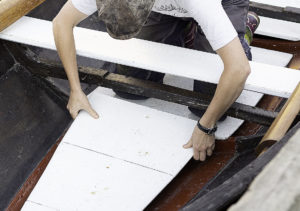
It is important to raise the floorboards when the boat is not in use, even when the boat is on the water. This will help preserve the bottom better over time.
Tarred boats
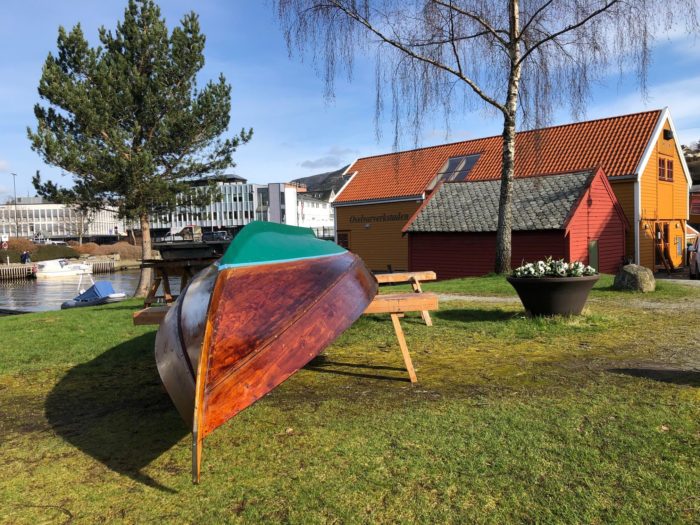
If you have ordered a tarred boat from the workshop, the treatment the boat is delivered with must be considered as basic priming. Boat owners must the grease the boat themselves once or twice a year during the first few years. Boat owners must assess whether the boat needs greasing in the autumn and spring.
Regular care:
- Wash the boat with water and soft soap when the boat has been taken ashore for a longer period, for example when the boat is stored for the winter.
- Apply tar/tar mixture if the wood is dry. In many cases, it is enough to grease the outer wood in the autumn and the whole boat in the spring. (PHOTO, dry wood and tar.)
- Boats that are kept for long periods on the water also need to be greased more often.
Tar is best used pure, preferably heated in a water bath to around 50-60 degrees. This improves absorption into the wood and makes it easy to apply. Tar can also be mixed with methylated spirit, turpentine or oil. Linseed oil is currently the most popular oil, but fish liver oil (light) has been used in earlier times.
If you want a golden brown surface on your boat, tar can be mixed 50/50 with linseed oil. You have to make sure you find premium quality light-coloured tar. This tar must be stored in a wooden barrel or plastic container, as the tar will turn black if it is stored in an iron container. The best tar is reddish brown, light and smooth when rubbed between the fingers.
Tar needs sunlight to dry. It is beneficial if the boat is left for a few hours in the sun before treatment so that the wood is warm from the sun. This makes treatment easier, and the tar is better absorbed into the wood. The drying time for tar will vary depending on the tar quality, weather and temperature and whether the tar is mixed with other oils, turpentine or spirit. In good conditions, the tar can dry in 3-4 days, but it can take several weeks if the conditions are bad.
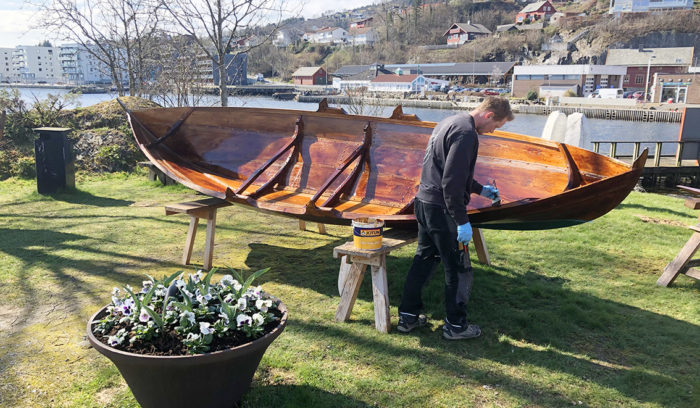
Please note that a boat that has been in the boathouse all winter and is dry, will tolerate being left in the sun to be treated. A boat that is waterlogged will not tolerate being left in the sun. This could cause the planks in the boat to crack due to hard drying.
Tip: If the wood is coated with tar and the boat is properly greased (no dry spots), but you think the boat looks dull and sad in the spring. then you can wash the boat with water and soft soap, and then wipe the boat with methylated spirit. This will make the dry tar surface shiny and attractive. PHOTO
More info on tar and tar treatment: www.arctandria.no (care and maintenance of boats, sails and rigging), www.delebanken.no (traditional maintenance of small boats)
Oiled/varnished boats (Jotun Clipper 1 and 2)
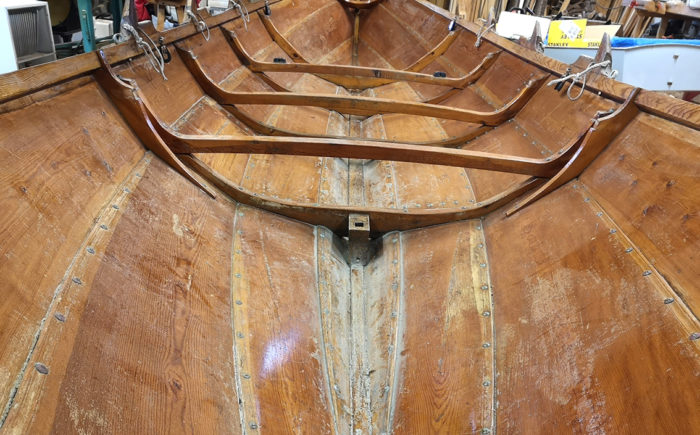
When the boat varnish is worn:
- Sand or scrape around bare spots until you see solid, bare wood.
- Oil the wood well until it is saturated, the type of oil depends of course on what oil has been used previously. Irrespective of type, it is important to make sure that the oil soaks well into the wood.
- Leave the oil to dry properly, preferably for 2-3 days.
- If some of the oil remains on the outside of the wood, it must be sanded with fine sandpaper and washed with a degreasing agent.
- Apply 3-4 coats of new top oil/varnish.
As time passes and the boat is used and worn, you must consider sanding/scraping down the entire boat and re-oiling and varnishing. When doing so, make sure that all places where the oil/varnish has been worn away or has come loose from the wood are sanded clean. Afterwards, the whole boat must be polished and cleaned. Areas of bare wood must be treated as above, before the whole boat is varnished/oiled with 2-3 coats of top oil.
More info about oil and varnish: www.jotun.com (how to carry out wood care and varnishing of a wooden boat),
Painting boats (linseed oil paint):
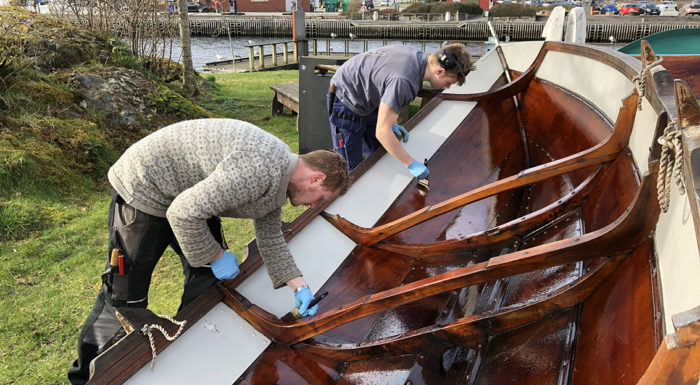
Oselvar boats are traditionally painted in light colours (light blue, light grey, light green or eggshell white) on the inside and treated with tar on the outside
The outside of the boat is then cared for as a tarred boat.
The linseed oil paint on the inside will eventually start to chalk, and should be washed with ammonia water (2 dl ammonia to 10 l water, wear gloves and glasses). You can then refresh the paint with a thin coat of pure, boiled linseed oil. Linseed oil must be left to cure in a ventilated area for 3-7 days after application.
When the linseed oil paint has worn away, it must be reapplied. More information about linseed oil paint and its use: www.ottossonfarg.se , www.byggogbevar.no (how to paint with linseed oil paint)
Below is an excerpt from “Church boats – Johannes Revheim”:
“The old people knew how to care for their boats. They were very concerned about them, both during use, and by not leaving them outside in all kinds of weather. Getting into the boat and sitting down in the right way (not climbing over the planks) was something the old people were particularly careful about.”
“Oars and floorboards were removed from the boat. The floorboards were often stacked beside the boat. The oars were placed across the cross-beams or on hooks that were attached to the wall in the boathouse. The sail was hung up to dry. The rudder also had its own place.”
From article by Peter Helland-Hansen, Hardanger Fartøyvernsenter:
Today, the rowing boats are usually left out for much of the summer. In olden times, the boats had to be stored in the boathouse when they were not in use. Immediately after returning home from church, the boat had to be washed and replaced in the boathouse. It was important to make sure the boat was placed nice and straight on its keel, to prevent distortion. The boats were therefore propped up using boat supports placed against the cross-braces or cross-beams. This ensured they were safely stored until the next boat trip, and did not get waterlogged or suffered unnecessarily from rain and wind.
Useful tips for old boats: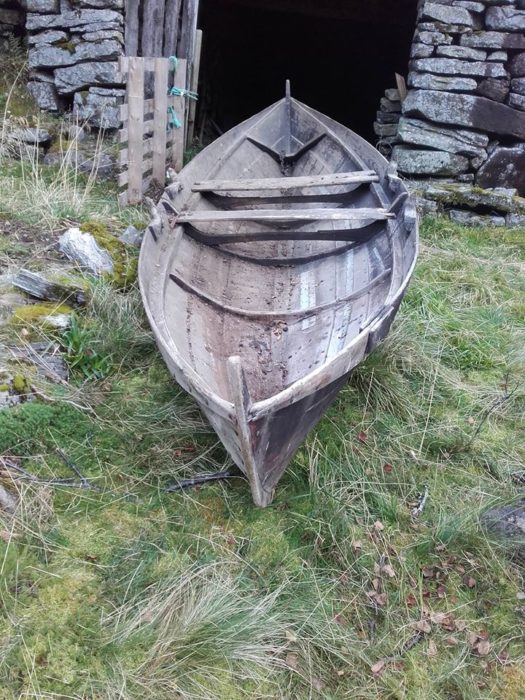
- Leaking boat? Check the joints between the strakes and keel.
- Cracks? Small cracks can be sealed using caulking. If it takes more than three days before the boat is sealed when on the water, it needs repair. A temporary solution can be margarine (with a lot of fat), or mutton tallow. You can also use Farm, which is an asphalt product. Large cracks should be milled, and then cover with ribs using glue.
- NB!: Do not use silicone-based sealants, as these will lead to rot damage.
- Can the boat be saved? Look for rot, everything that is rotten should be replaced. Poke the wood with a screwdriver. If you bring the boat to the Oselvar workshop, the boat builders can provide a report on the boat’s condition. The report costs NOK 500.
- Replacing old rivets? If the rivet is stuck, insert a new one in between the old rivets. Go up in size if you use the same hole for new rivets.
- Copper and iron? Due to galvanic corrosion, metals should not be mixed. Use the same type of metal already used in the boat.
- Gunwale rivet (rivet in the stem that is not clinkered). In general, gunwale rivets are difficult to pull out. You should therefore insert a new rivet between them.
- Seal between the strakes? Oil or tarred cotton thread, hemp or linen.
- Between the layers, you can use natural fiber material or thick paper permeated with oil-based varnish or tar.
- Anti-fouling? Use primer directly on wood, then normal anti-fouling treatment. On iron rivets, it may be a good idea to use a primer/rust paint before applying anti-fouling treatment.
